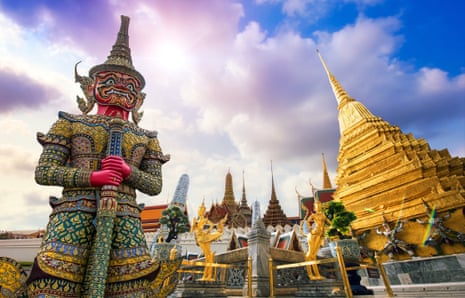Few cities assail the senses as viscerally as Bangkok, from the kinetic cacophony of its street life to its aromatic herbal cures and the incendiary spice of the food. Social distancing has only briefly withheld the touch of Thai massage and the jostle of its markets. Juxtapositions startle the eye, with designs often decided by fortune tellers or sacred colours. Timber shacks abut glitzy towers of novelty shapes in the world’s third least equal society.
Breakneck modernisation has sparked tensions between the cosmopolitan “hi-so” (high society) and grassroots values, while young reformers protest at the seniority system that enforces a hidden order behind the apparent chaos. Amid the hi-tech towers, a vast informal economy wheels food stalls and makes street furniture from found materials. It’s both fun and poignant to ride around the teeming centre on motorcycle taxis, converted pickup trucks or canal boats with a hinged canvas roof that lowers under bridges.
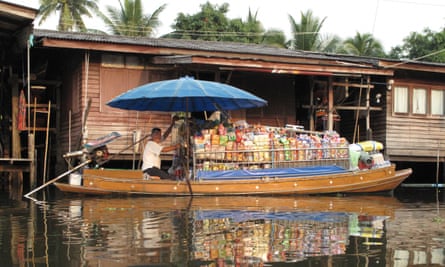
Author and composer SP Somtow called it a “city both futuristic and feudalistic, a city where the first and third worlds were in endless collision”, in his book The Crow: Temple of Night. Others say this village-minded megalopolis is Blade Runner-esque.
Returning tourists will find its tangled laneways opened up by fresh routes. New rapid urban railways link neglected districts, and will meet the trans-Asian network at the new Bang Sue Grand station. Driverless Gold Line trains run to the huge IconSiam riverside mall, and on to Kudi Jeen, a 250-year-old quarter first settled by Persians and Portuguese, Hokkien Chinese and Mon people from Myanmar. Paths lead to a waterfront cafe named My Grandparents’ House, embodying the trend of rediscovering once-supressed Chinese heritage.
London never got its garden bridge, but Bangkok last year opened the leafy SkyPark, spanning the Chao Praya river from Kudi Jeen to Chinatown. Its undulations afford views downstream, where skyscrapers bristle like a hairbrush, and upstream to the Grand Palace, the temple of the reclining Buddha, and Wat Arun, the city’s five-spired symbol. Mosaicked in particoloured glass and china, Bangkok’s temples are, to cite Somerset Maugham in his 1935 travelogue The Gentleman in the Parlour, “unlike anything in the world … and you cannot fit them into the scheme of things you know. It makes you laugh with delight that anything so fantastic could exist on this sombre Earth.”

The SkyPark leads right to the old moat, Khlong Ong Ang, where markets have been cleared to make canalside promenades lined with Instagram-ready murals of Sikhs, Muslims and Teochew Chinese traders. The country’s multi-ethnic past is being repackaged into a digestible “diverse” Thainess. But as William Warren warned in his 2012 portrait of the city, Bangkok, “the result of this successful assimilation has been the steady decline, virtually the disappearance, of anything purely Thai”.
Chinatown, too, is relinquishing its mysteries as shophouses turn into galleries, bars and hostels. Crumbling stucco alleys strewn with engine parts draw hipsters during the Chinese Vegetarian Festival, Bangkok Design Week and regular Galleries Nights. Siam’s first paved street, Charoenkrung Road, arcs through here into Bangrak Creative District, an independent initiative by young urbanites that bypasses the state’s orderliness to make a virtue of the varied chaos.
See
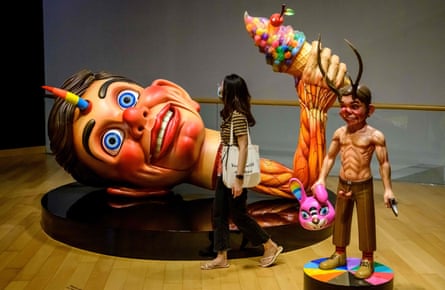
Bangkok Vanguards pioneered neighbourhood tours here. You can now join them via Zoom, either as a live-streamed scooter trip or a video tour narrated by the guide. From Khlong Ong Ang, you thread through the passages of Saphan Han with its community leader, encountering a jewellery workshop, a sala pao dumpling stall and a shrine to their Teochiu deity, Pun Tao Kong.
Across the moat from Saphan Han are the neighbourhoods of Little India and Wang Burapha, which was the first Thai hub of pop culture. That history is told in one of the virtual exhibitions at the irreverent Museum Siam, viewable alongside ones of nearby Tha Tien market plus the museum’s irreverent take on nationalism, Decoding Thainess.

Photograph: Philip Cornwel-Smith
Museum Siam was a venue for the recent Bangkok Art Biennale, one of the few biennials to go ahead last year. Its pavilions can still be toured online. Among the 82 artists from 35 countries, Anish Kapoor adapted a wax installation for the prayer hall of Wat Pho. The 31 Thai artists include Wasinburee Supanichvoraparch, whose porcelain tanks capture the fragility of power, Peerachai “Samer” Patanaporgchai, a homeless savant whose graffiti of elaborate paranoid diagrams is a familiar sight across downtown, and Charit Pusiri’s peep show on Bangkok life.
Watch

Bangkok’s reputation is at its most compulsively lurid in The Hangover Part II, a bachelor party caper that spawned Hangover guided tours and the catchphrase: “Bangkok has him now.” The best films about this city aren’t being streamed, but Netflix has several popular dramas: Bangkok Traffic Love Story, which deals with contemporary mores; Hormones (2013-15), the first Thai series to tackle youth issues with provocative realism; and time-travel fantasy series Love Destiny (2018), which contrasts today’s affluent lifestyle with 17th-century courtiers, sparking a fad for wearing traditional dress to events.
The 1840s story of the ghost of Mae Nak – who sees her beloved husbandsent off to war and later dies in childbirth in what is now the Phrakhanong neighbourhood – has sparked countless films, from the sumptuous 1999 romance Nang Nak to the 2013 horror-comedy Pee Mark Phrakhanong, about her hapless husband. In a documentary on the city’s visual culture, World In Motion: Bangkok, I guide you through Nak’s shrine at Wat Mahabut.
Taste
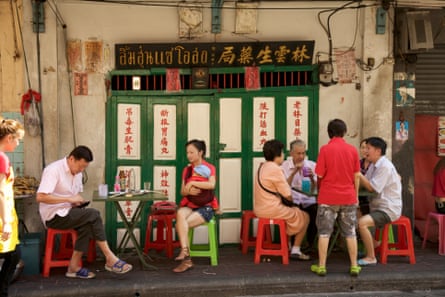
In her food blog She Simmers, Leela Punyaratabandhu dissects how the TV series Love Destiny contrasted ancient and current recipes, such as a dip for grilled fish. Her cookbook Bangkok: Recipes and Stories from the Heart of Thailand, explains the foreign influences upon its hybrid cuisine, and comes with YouTube demonstrations. She reveals how a Thai prime minister famously added a splash of brandy when cooking his green curry with beef. While other curries can get away with pre-made pastes, she insists that green curry paste is best made fresh, toasting the coriander seeds and cumin before grinding with the herbs and shrimp paste.
But Bangkok’s most famous cooking class, which also sparked a book and YouTube clips with Jamie Oliver, earned fame initially for its title: Cooking With Poo. Chef Saiyuud Diwong – nicknamed Poo (crab) – proudly stayed based in the Khlong Toey slum where she grew up.
The first Michelin star for Thai food went to Australian chef David Thompson at Bangkok’s Como hotel, whose two cookbooks, Thai Food and Thai Street Food, are laced with cultural context. The latter spawned a TV series (on Vimeo), partly set in Bangkok, which demonstrates how to brown a Sino-Thai oyster omelette using pork fat and tapioca flour.
Listen
The aural equivalent of the exploding flavour pockets in Thai cuisine is molam, the north-eastern music introduced by migrants from the Thai and Laotian hinterlands since the 17th century. It’s the music most busked on the streets, often by groups of blind musicians. Spotify streams the Paradise Bangkok Molam International Band, a supergroup of master players who blended the plaintively warbled vocals and bamboo khaen pipes with surf rock and Latin rhythms that get anyone churning to its infectious beats.
Bangkok pop feels bland by comparison, with copycat sounds, K-pop formulas and tonal vocals that can sound off-key. Yet some Bangkok-born artists earn fans abroad by singing in English. Phum Viphurit sings fetching jangly tunes and one of Hugo Chakrabongse’s blues-infused rock ballads has been covered by Beyoncé.
Thai rap ranges from the polished sound of Thaitanium on Mahanakorn and with Snoop Dogg on Wake Up (Bangkok City), to slum homeboys such as 19Tyger rapping about Khlong Toey. Protest songs by the collective Rap Against Dictatorship changed Thai politics, with a 100 million YouTube views of the taboo-shattering invective Prathet Ku Mee (What My Country’s Got).
Read
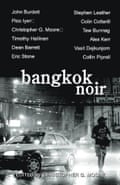
Bangkok Noir (2011) gives short-story tastes of Bangkok’s detective genre set in seedy locales like Soi Cowboy. “Noir in Bangkok happens fast,” notes its editor, Christopher G Moore, talking of how it is fed by folk beliefs and the news. “At every turn there is a new noir-like incident, such as the temple morgue found to contain two thousand aborted foetuses. Take a late night walk through some poor neighbourhoods. Hear the soi dogs howling as the angry ghosts launch themselves through the night, and observe that modern possessions don’t stop the owners from making offerings to such spirits.”

Leading literary expat Lawrence Osborne dissects the ambiguity of outsiders in his travelogue Bangkok Days and condominium-set thriller The Glass Kingdom. “Bangkok is an asylum for those who have lapsed into dilettantism,” he quips. “Westerners choose Bangkok as a place to live precisely because they can never understand it.” And it’s no less of an enigma to Thais.
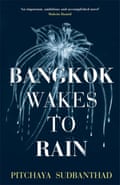
Some local authors published in English try to unblock the policed blanks in the national memory. In Bangkok Wakes to Rain, Pitchaya Sudbanthad tracks a wooden house over centuries via its conversion into a spa to its fate in a flooded future Bangkok, evoking the city’s sensory hit. “A pearl-eyed lottery seller, sensing passersby from footsteps and the clap of flip-flops, calls out of an opened case of clothes-pinned tickets to whoever craves luck. Her nose picks up the ashen smell always in the air.” Like indie novellist Veeraporn Nitiprapha in The Blind Earthworm in the Labyrinth, he uses metaphor to tackle scandals that most try to forget. As Pitchaya dryly notes: “The not remembering doesn’t really work, does it?”
Philip Cornwel-Smith was the founding editor of Bangkok’s first listings magazine, Metro, and the Time Out City Guide to Bangkok. His latest book is Very Bangkok: In the City of the Senses (River Books, £20)
